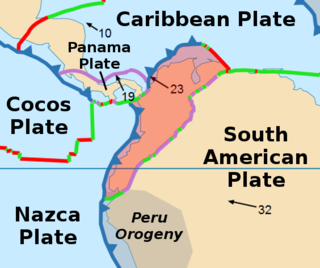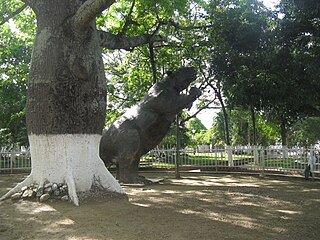
Kinorhyncha is a phylum of small marine invertebrates that are widespread in mud or sand at all depths as part of the meiobenthos. They are commonly called mud dragons. Modern species are 1 mm (0.039 in) or less, but Cambrian forms could reach 4 cm (1.6 in).

A tergum is the dorsal ('upper') portion of an arthropod segment other than the head. The anterior edge is called the 'base' and posterior edge is called the 'apex' or 'margin'. A given tergum may be divided into hardened plates or sclerites commonly referred to as tergites.

The Roman Catholic Archdiocese of Durango is a Metropolitan Archdiocese in Mexico. Based in the city of Durango, it is the metropolitan see for the suffragan dioceses of Gómez Palacio, Mazatlán and Torreón as well as the Territorial Prelature of El Salto.
The National Prize for Arts and Sciences is awarded annually by the Government of Mexico in six categories. It is part of the Mexican Honours System and was established in 1945. The prize is a gold medal and 520,000 pesos.

The governor of San Luis Potosí exercises the role of the executive branch of government in the Mexican state of San Luis Potosí, per the Political Constitution of the Free and Sovereign State of San Luis Potosí. The official title is Gobernador Constitucional del Estado Libre y Soberano de San Luis Potosí.

The North Andes plate or North Andes block is a small tectonic plate (microplate) located in the northern Andes. It is squeezed between the faster moving South American plate and the Nazca plate to the southwest. Due to the subduction of the Coiba and Malpelo plates, this area is very prone to volcanic and seismic activity, with many historical earthquakes.
Fernando Cepeda Ulloa is a Colombian political scientist, professor and diplomat. He has served as Ambassador of Colombia to the United Kingdom, to France, and to Canada, as Permanent Representative of Colombia to the United Nations and to the Organization of American States, and as Chargé d'affaires of the Colombian Legation to the United States as Minister Plenipotentiary.

The Honda Group is a geological group of the Upper and Middle Magdalena Basins and the adjacent Central and Eastern Ranges of the Colombian Andes. The group, in older literature also defined as formation, is in its present-day type section in the Tatacoa Desert in the department of Huila subdivided into two main formations; La Victoria and Villavieja.

The Cuche Formation is a geological formation of the Floresta Massif, Altiplano Cundiboyacense in the Eastern Ranges of the Colombian Andes. The sequence of siltstones, shales, and sandstone beds dates to the Late Devonian and Early Carboniferous periods, and has a maximum thickness of 900 metres (3,000 ft).

Echinoderidae is a family of kinorhynchs in the class Cyclorhagida.

Pycnophyidae is a family of kinorhynchs in the class Allomalorhagida.

Echinoderes is a genus of mud dragons first described in 1863. It is the largest genus within class Kinorhyncha. It is a highly diverse genus, with member species that inhabit "most marine benthic substrates, on latitudes ranging from the Arctic to the tropics, and from the intertidal zone down to the deep sea." Species on the east coasts of North and South America have been extensively studied by Robert P. Higgins. Species in east Asia have been extensively studied by A. V. Adrianov.

Pycnophyes is a genus of mud dragons belonging to the family Pycnophyidae.
Cristaphyes is a genus of worms belonging to the family Pycnophyidae.
Paracentrophyes is a genus of worms belonging to the family Neocentrophyidae.
Fujuriphyes is a genus of kinorhynchs within the family Pycnophyidae, with 9 species currently assigned to the genus.
Fujuriphyes hydra is a species of mud dragon within the family Pycnophyidae. It was described from the Mozanbique Channel after an investigation on 2 pockmarks. The species name hydra comes from the name of the fictional deity Hydra created by H.P. Lovecraft.








